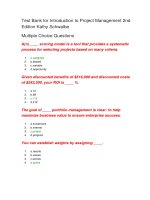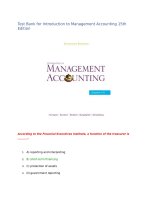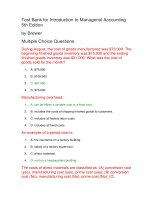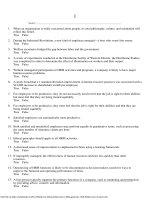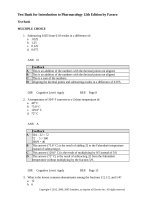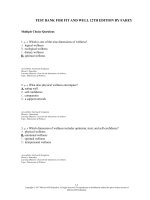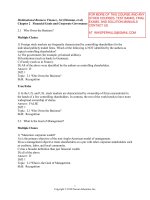Test bank for introduction to pharmacology 12th edition by favaro
Bạn đang xem bản rút gọn của tài liệu. Xem và tải ngay bản đầy đủ của tài liệu tại đây (55.9 KB, 10 trang )
Test Bank for Introduction to Pharmacology 12th Edition by Favaro
Test Bank
MULTIPLE CHOICE
1. Subtracting 0.025 from 0.10 results in a difference of:
a. .0125
b. 1.25
c. 0.125
d. 0.075
ANS: D
A
B
C
D
Feedback
This is an addition of the numbers with the decimal points not aligned.
This is an addition of the numbers with the decimal points not aligned.
This is a sum of the numbers.
Aligning the decimal points and subtracting results in a difference of 0.075.
DIF:
Cognitive Level: Apply
REF: Page 8
2. A temperature of 104° F converts to a Celsius temperature of:
a. 40° C
b. 75.6° C
c. 129.6° C
d. 72° C
ANS: A
A
B
C
D
Feedback
104 – 32 = 72
72 5 = 360
360/9 = 40
This answer (75.6° C) is the result of adding 32 to the Fahrenheit temperature
instead of subtracting it.
This answer (129.6° C) is the result of multiplying by 9/5 instead of 5/9.
This answer (72° C) is the result of subtracting 32 from the Fahrenheit
temperature without multiplying by the fraction 5/9.
DIF:
Cognitive Level: Apply
REF: Page 13
3. What is the lowest common denominator among the fractions 1/3, 1/2, and 1/4?
a. 12
b. 6
Copyright © 2012, 2009, 2005 Saunders, an imprint of Elsevier Inc. All rights reserved.
Full file at />c. 5
d. 24
ANS: A
A
B
C
D
Feedback
The smallest number that is divisible by all three denominators (3, 2, 4) is 12.
Four does not divide evenly into 6.
None of the denominators divide evenly into 5.
Although all of the denominators divide evenly into 24, it is not the smallest
common denominator.
DIF:
Cognitive Level: Remember
REF: Page 4
4. Dividing 0.75 by 0.25 results in a quotient of:
a. 30
b. 3.00
c. 0.1875
d. 0.50
ANS: B
A
B
C
D
Feedback
This answer is the result of dividing 0.75 by 0.025.
After moving the decimal places over two positions in the divisor and the
dividend, then proceeding with division, the result is the whole number 3.
This is the product of the two numbers, not the quotient.
This is the result of subtracting 0.25 from 0.75.
DIF:
Cognitive Level: Apply
REF: Page 9
5. One centimeter is equal to how many millimeters?
a. 100 mm
b. 1000 mm
c. 1/10 mm
d. 10 mm
ANS: D
A
B
Feedback
1 cm = 10 mm, not 100 mm.
1 cm = 10 mm, not 1000 mm.
Copyright © 2012, 2009, 2005 Saunders, an imprint of Elsevier Inc. All rights reserved.
Full file at />C 1 cm = 10 mm, not 1/10 mm.
D 1 cm = 10 mm.
DIF:
Cognitive Level: Remember
REF: Page 13
6. Eighteen is 30% of:
a. 540
b. 60
c. 0.06
d. 54
ANS: B
A
B
C
D
Feedback
This answer (540) is the result of multiplying 18 by 30. (This is not the correct
way to determine percentage.)
18 = 30%x
18 = 0.30x
18/0.30 = x
18/0.30 = 60
This answer (0.06) is the result of dividing 0.018 by 0.30. (This eliminates the
step of moving the decimal to the right to create a divisor that is a whole number.)
This answer (54) is the result of multiplying 18 by 3 instead of dividing by 0.30.
DIF:
Cognitive Level: Apply
REF: Page 11
7. The ratio 3:100 would properly be expressed in fraction form as:
a. 0.003
b. 3/100
c. 100/3
d. 33 1/3%
ANS: B
A
B
C
D
Feedback
This is decimal form and not expressed as a fraction.
Ratio indicates division, and the fraction 3/100 also represents the same operation
of three parts of 100.
This fraction represents 100 3.
This is percentage form and not a fraction.
DIF:
Cognitive Level: Remember
REF: Page 7
Copyright © 2012, 2009, 2005 Saunders, an imprint of Elsevier Inc. All rights reserved.
Full file at />8. Three teaspoons equal how many milliliters?
a. 30 mL
b. 45 mL
c. 100 mL
d. 15 mL
ANS: D
A
B
C
D
Feedback
30 mL = 6 teaspoons.
45 mL = 9 teaspoons.
100 mL = 20 teaspoons.
1 teaspoon = 5 mL; 3 teaspoons = 15 mL.
DIF:
Cognitive Level: Remember
REF: Page 14
9. In the proportion 2.5 : x :: 500 : 600, the unknown is:
a. 120,000
b. –40
c. 3
d. 2.08
ANS: C
A
B
C
D
Feedback
This answer (120,000) is the result of multiplying the two terms on the right (500,
600) and dividing by the numeric term on the left (2.5).
This answer (–40) is the result of subtracting the two terms on the right (500, 600)
and dividing by the numeric term on the left (2.5).
This answer (3) is the result of multiplying the means and the extremes and then
dividing to find the unknown.
This answer (2.08) is the result of multiplying an extreme (2.5) by a mean (500)
and dividing by the other extreme (600).
DIF:
Cognitive Level: Remember
REF: Page 12
10. Expressed in Roman numerals, the number 2009 is:
a. IIIV
b. MMIIII
c. MMIX
d. IVMM
Copyright © 2012, 2009, 2005 Saunders, an imprint of Elsevier Inc. All rights reserved.
Full file at />ANS: C
A
B
C
D
Feedback
This Roman numeral is not consistent with the syntax for the numbering system.
This Roman numeral is not consistent with the syntax for the numbering system.
The symbols for 1000 (M) are added, making 2000, and the number for 1 (I) is
subtracted from the number for 10 (X), giving 9.
This Roman numeral is not consistent with the syntax for the numbering system.
DIF:
Cognitive Level: Apply
REF: Page 1 and 2
PROBLEM
1. Convert 1/500 to a decimal.
ANS:
0.002
1 500 = 0.002
DIF:
Cognitive Level: Apply
REF: Page 10
2. Convert 0.375 to a fraction.
ANS:
3/8
0.375 = 375/1000; reduced by dividing both numbers by 125 = 3/8
DIF:
Cognitive Level: Apply
REF: Page 10
3. Convert the following: 293° F = x° C.
ANS:
145° C
(5/9) (293 – 32) = 145
DIF:
Cognitive Level: Apply
REF: Page 13
4. Solve for x in the following proportion: 1/4 : 6 :: 3 : x.
ANS:
72
6 3 = 1/4x; 18 = 1/4x; (1/4)(18) = 72
DIF:
Cognitive Level: Apply
REF: Page 12
5. Change 4 3/4 to an improper fraction.
Copyright © 2012, 2009, 2005 Saunders, an imprint of Elsevier Inc. All rights reserved.
Full file at />ANS:
19/4
(4 = 16/4) + 3/4 = 19/4
DIF:
Cognitive Level: Apply
REF: Page 3
6. Solve for x in the following equivalent fraction: 100/x = 50/25
ANS:
x = 50
100 25 = 2500; 50 x = 50x; 2500/50 = 50
DIF:
Cognitive Level: Apply
REF: Page 4
7. Solve for x in the following proportion: 0.25 : 10 :: x : 1
ANS:
0.025
10x = (1 0.25); x = 0.25/10 = 0.025
DIF:
Cognitive Level: Apply
REF: Page 12
8. What is 1/4% of 20?
ANS:
0.05
1/4% = 0.0025; 0.0025 20 = 0.05
DIF:
Cognitive Level: Apply
REF: Page 10 and 11
9. Convert the following units: 143 lb = x kg
ANS:
65 kg
1 kg = 2.2 lb; 143/2.2 = 65
DIF:
Cognitive Level: Apply
REF: Page 14
10. Convert 16/100 to a decimal.
ANS:
0.16
16 100 = 0.16
DIF:
Cognitive Level: Apply
REF: Page 10
11. Write CXLVII as an Arabic numeral.
Copyright © 2012, 2009, 2005 Saunders, an imprint of Elsevier Inc. All rights reserved.
Full file at />ANS:
147
C = 100, X = 10, L = 50, V = 5, I = 1
100 + (50 – 10) + (5 + 2)
DIF:
Cognitive Level: Apply
REF: Page 1 and 2
12. Solve for x in the following proportion: 1/5 :1 :: 20 : x
ANS:
100
1/5x = 20 1; x = 5 20
DIF:
Cognitive Level: Apply
REF: Page 12
13. Solve for x in the following equivalent fraction: x/16 = 6/32
ANS:
x=3
16 6 = 96; 32 x = 32x (Dividing both sides by 32 yields x = 3.)
DIF:
Cognitive Level: Apply
REF: Page 4
14. Convert the following units: 1 tablespoon = x mL
ANS:
15 mL
1 teaspoon = 5 mL; 1 tablespoon = 3 teaspoons
3 5 = 15
DIF:
Cognitive Level: Apply
REF: Page 14
15. Convert the following: 38° C = x° F
ANS:
100.4° F
(9 × 38 + 160)/5 = 100.4
DIF:
Cognitive Level: Apply
REF: Page 13
16. Write MDCCLXXVI as an Arabic numeral.
ANS:
1776
M = 1000, D = 500, C = 100, L = 50, X = 10, V = 5, I = 1
1000 + (1000 – 300) + (50 + 20) + (5 + 1)
Copyright © 2012, 2009, 2005 Saunders, an imprint of Elsevier Inc. All rights reserved.
Full file at />DIF: Cognitive Level: Apply
REF: Page 1
17. Find the lowest common denominator: 1/3, 5/4, 3/5
ANS:
LCD = 60
3 4 = 12; 12 5 = 60 (Sixty is the smallest number divisible by all three denominators.)
DIF:
Cognitive Level: Apply
REF: Page 4
18. Convert 1/8 to a decimal.
ANS:
0.125
1 8 = 0.125
DIF:
Cognitive Level: Apply
REF: Page 10
19. Three is what percent of 5?
ANS:
60%
3 is 3/5 of 5; 3 divided by 5 = 0.60 or 60%
DIF:
Cognitive Level: Apply
REF: Page 11
20. Solve for x in the following proportion: 9 : 6 :: x : 30
ANS:
45
6x = 9 30; 6x = 270; 270 6 = 45
DIF:
Cognitive Level: Apply
REF: Page 12
21. Solve for x in the following equivalent fraction: 3/6 = x/12
ANS:
x=6
3 12 = 36; 6 x = 6x (Dividing both sides of 36 = 6x by 6 yields 6 = x.)
DIF:
Cognitive Level: Apply
REF: Page 4
22. Write 1888 as a Roman numeral.
ANS:
MDCCCLXXXVIII
M = 1000, D = 500, C = 100, L = 50, X = 10
1000 + 500 + 100 + 100 + 100 + 50 + 10 + 10 + 10 + 5 + 1 + 1 + 1
Copyright © 2012, 2009, 2005 Saunders, an imprint of Elsevier Inc. All rights reserved.
Full file at />DIF:
Cognitive Level: Apply
REF: Page 1 and 2
23. Change 15 3/8 to an improper fraction.
ANS:
123/8
(15 = 120/8) + 3/8
DIF:
Cognitive Level: Apply
REF: Page 3
24. Convert the following: 68° F = x° C
ANS:
20° C
(5/9) (68 – 32) = 20
DIF:
Cognitive Level: Apply
REF: Page 13
25. Find the lowest common denominator: 1/8, 1/4, 1/32
ANS:
LCD = 32
8 4 = 32 (Thirty-two is the smallest number divisible by all three denominators.)
DIF:
Cognitive Level: Apply
REF: Page 4
26. Convert the following units: 30 mL = x fl oz
ANS:
1 fl oz
1 fl oz = 30 mL
DIF:
Cognitive Level: Apply
REF: Page 14
27. What percent of 25 is 5?
ANS:
20%
5 is 1/5 of 25; 1 divided by 5 = 0.20 or 20%
DIF:
Cognitive Level: Apply
REF: Page 11
28. Convert 6.25 to a fraction.
ANS:
25/4 or 6 1/4
0.25 is the same as 25/100; dividing the numerator and denominator by 25 = 1/4
Copyright © 2012, 2009, 2005 Saunders, an imprint of Elsevier Inc. All rights reserved.
Full file at />DIF:
Cognitive Level: Apply
REF: Page 10
29. Solve for x in the following proportion: 5 : 25 :: x : 100
ANS:
20
25x = 5 100; x = 500/25
DIF:
Cognitive Level: Apply
REF: Page 12
Copyright © 2012, 2009, 2005 Saunders, an imprint of Elsevier Inc. All rights reserved.
